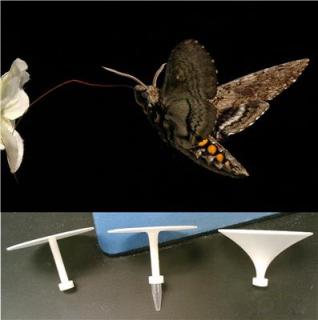Apr 16 2015
Eric Campos and colleagues from the University of Washington have produced artificial flowers using 3D printing to study the effect of flower shape on the foraging mechanism of the hawkmoth Manduca sexta.
 Manduca sexta probing an artificial flower with its proboscis (Image credit: Armin Hinterwirth)
Manduca sexta probing an artificial flower with its proboscis (Image credit: Armin Hinterwirth)
3D printing is now applied in various disciplines ranging from cars to medical implants. Ecologists use this technology to produce artificial flowers that allow them to gain knowledge on plant-pollinator interactions.
The study is published in the British Ecological Society's journal Functional Ecology.
Even before the work of Charles Darwin, flower shape attracted ecologists to study the effect animal pollinators had on the evolution of floral traits. However, investigation on pollinator behavior is extremely difficult. Ecologists have either used hand-made flowers, using paper maché, or depended on plant breeding means to study the flower shapes. The former is a time-consuming procedure that complicates the analysis of test results.
The researchers produced two flowers of different shapes; one curved design in the form of a trumpet and the other a flat disc with a center hole. They added sugar water to each artificial flower to trigger the real flowers' nectar followed by arranging curved and flat flowers in equal quantities on a square grid. The hawkmoths were then allowed to freely fly around these flowers for five minutes. Finally, they compared the number of flower shapes interacted with by the moths.
The results showed that more moths were successfully fed from the curved flowers when compared to the flat flowers. This proves that touch instead of sight, is the primary means of finding nectar by nocturnal species.
With their long proboscis and nocturnal habits, finding a flower's nectar source isn't easy for the fist-sized hawkmoths we used in our study. Imagine being given a garden hose that's almost twice your height in length. Now imagine trying to thread the other end through a hole that's scarcely wider than the hose itself – at dusk as the sun is setting or at night during a full moon. It may seem like a silly proposition, but it's not too far off from what night-flying hawkmoths have to contend with to get a meal.
Eric Campos - University of Washington
By employing 3D printing to produce artificial flowers, the research potentially paves way for further study of animal pollinators and their evolutionary role in shaping natural flowers.
“3D printing is a unique opportunity to explore the interactions between floral form and pollinator performance. Our ability to manipulate mathematically-specified flower morphology means that we can investigate the role of minute but potentially important differences in floral form on pollinator foraging performance.” Campos said, “Such studies can help elucidate the details of how pollinator visitation influences the evolution of floral shape in nature, and the extent to which floral forms are the result of specializations between one plant and one pollinator species,” he concluded.
The hawkmoth Manduca sexta, also called the tobacco hornworm (as it feeds on tobacco), is commonly found in the Southern and Southeastern parts of the USA. The adult moths, with a fist-sized wingspan and human thumb-sized body, are skilled in flying and hovering in order to feed from trumpet-shaped flowers including Nicotiana, Petunia and Datura.